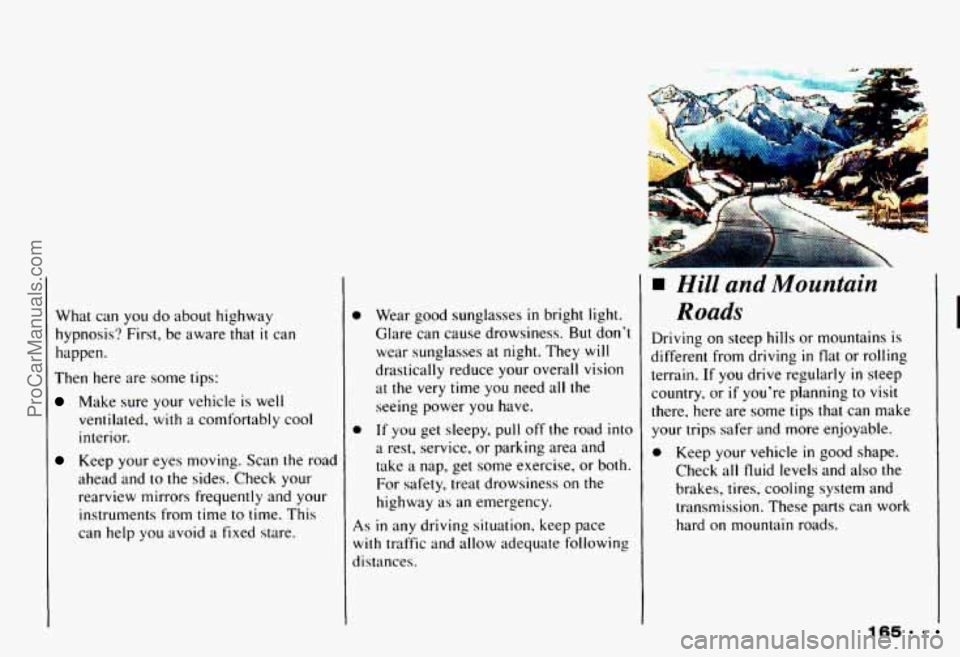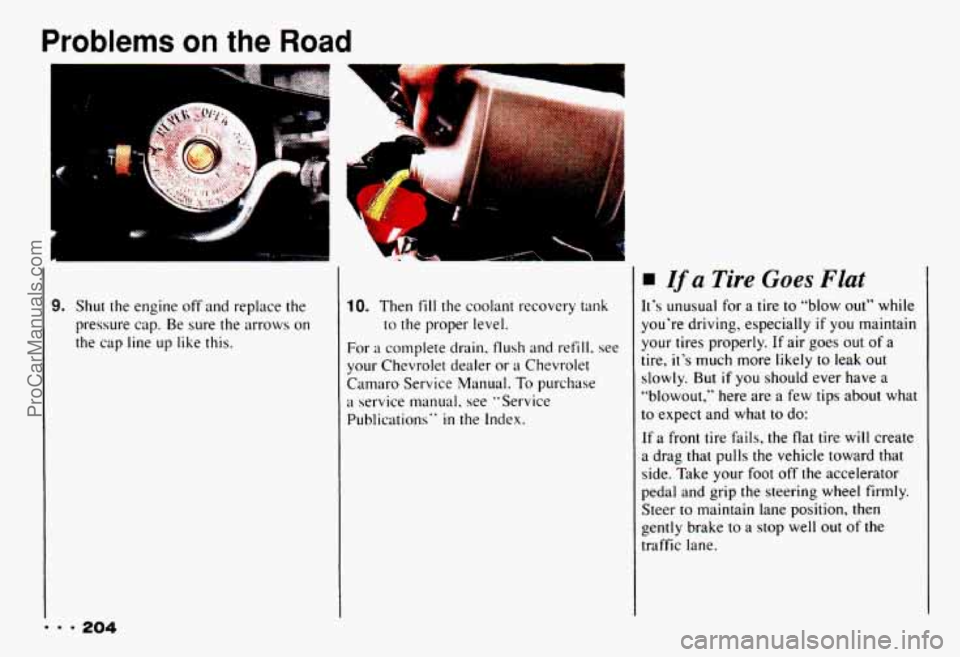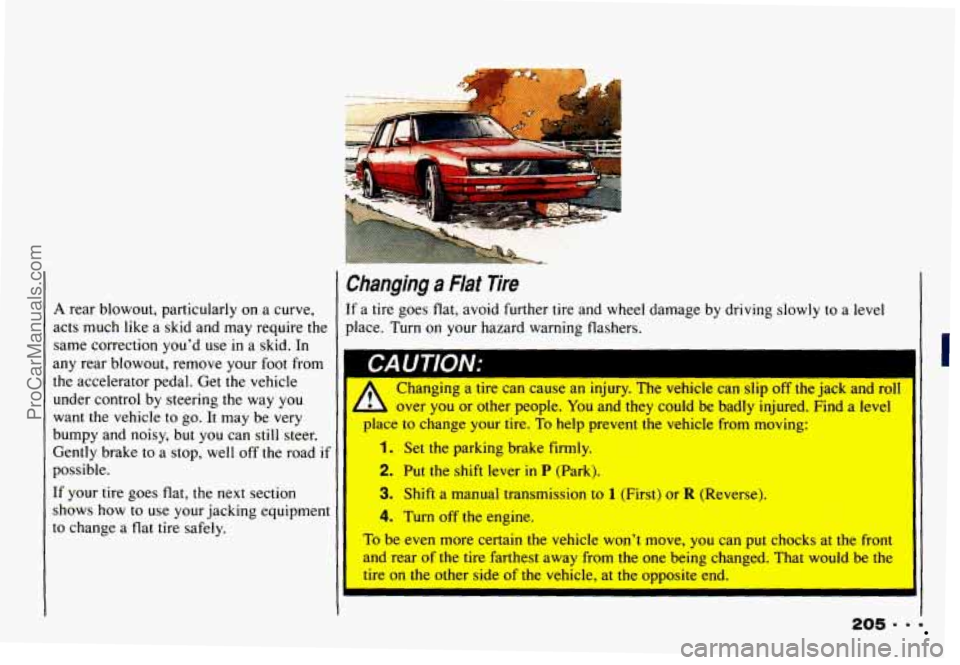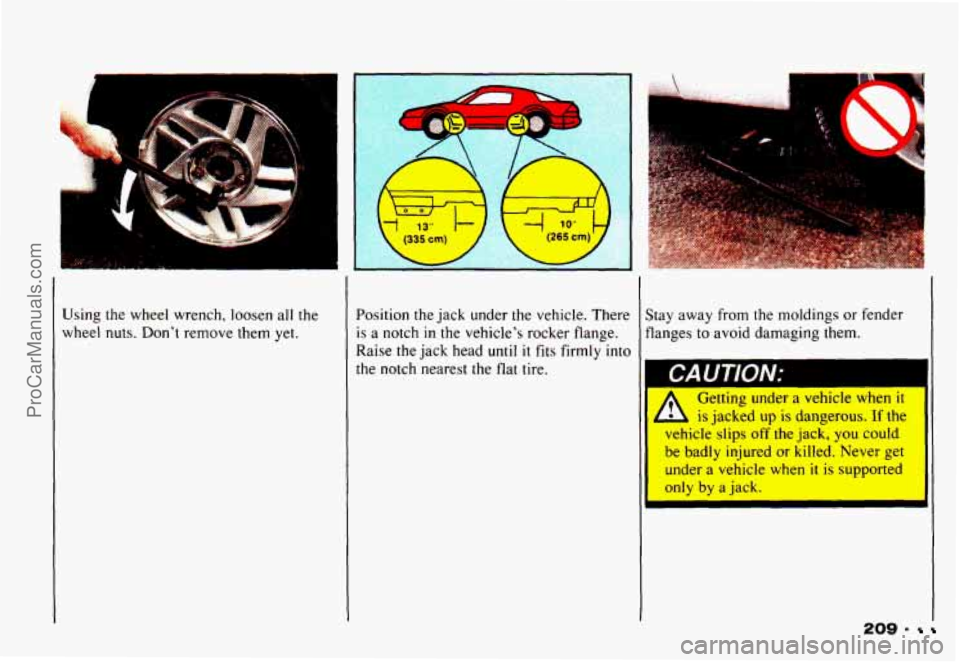1993 CHEVROLET CAMARO flat tire
[x] Cancel search: flat tirePage 8 of 358

How to Use This Manual
How to Use This
Manual
Many people read their owner’s manual
from beginning to end when they first
receive their new vehicle. This will help
you learn about the features and controls
for your vehicle. In this manual, you’ll
find that pictures and words work
together to explain things quickly.
Index: A good place to look for what
you need is
the Index in back of the
manual. It’s an alphabetical list of all
that’s
in the manual, and the page
number where you’ll find it.
Parts 1-8: Each part of this manual
begins with a brief list of its contents,
so
you can often find at a glance if a part
contains the information you want.
How to Use This Manual
This part tells you how to use your
manual and includes safety and vehicle
damage warnings and symbols.
Part 1: Seats & Safety Belts
This part tells you how to use your seats
and safety belts properly.
Part 2: Features & Controls
This part explains how to start and
operate your Chevrolet.
Part 3: Comfort Controls & Audio
Systems
This part tells you how to adjust the
ventilation and comfort controls and
how to operate your sound system.
Part 4: Your Driving and the Road
Here you’ll find helpful information and
tips about the road and how to drive
under different conditions.
Part 5: Problems on the Road
This part tells you what to do if you
have a problem while driving, such as a
flat tire or engine overheating.
Part 6: Service & Appearance Care
Here the manual tells you how to keep
your Chevrolet running properly and
looking
good.
Part 7: Maintenance Schedule
This part tells when to perform vehicle
maintenance and what fluids and
lubricants to use.
ProCarManuals.com
Page 167 of 358

Driving a Long
Distance
Although most long trips today are made
on freeways, there are
still many made on
regular highways.
Long-distance driving on freeways and
regular highways
is the same in some
ways. The
trip has to be planned and the
vehicle prepared, you drive at
higher-than-city speeds, and there are
longer turns behind the wheel. You’ll
enjoy your trip more
if you and your
vehicle are
in good shape. Here are some
:ips for a successful long trip.
Before Leaving on a Long Trip
Make sure you’re ready. Try to be well
rested. If you must start when you’re not
fresh
- such as after a day’s work -
don’t plan to make too many miles that
first part of the journey. Wear comfortable
clothing and shoes you can easily drive
in.
Is your vehicle ready for a long trip? If
you keep
it serviced and maintained, it’s
ready to go. If
it needs service, have it
done before starting out. Of course, you’ll
find experienced and able service experts
in Chevrolet dealerships all across North
America. They’ll be ready and willing to
help
if you need it. Here
are some things you can check
before a trip:
0
0
0
0
0
Windshield Washer Fluid: Is the
reservoir
full? Are all windows clean
inside and outside?
Wiper Blades: Are they in good
shape?
Fuel, Engine Oil, Other Fluids:
Have you checked all levels?
Lights: Are they all working? Are the
lenses clean?
Tires: They are vitally important to a
safe, trouble-free trip.
Is the tread
good enough for long-distance
driving? Are the tires all inflated to
the recommended pressure?
163 -
ProCarManuals.com
Page 169 of 358

What can you do about highway
hypnosis'? First, be aware that
it can
happen.
Then here are some tips:
Make sure your vehicle is well
ventilated,
with a comfortably cool
interior.
Keep your eyes moving. Scan the road
ahead and
to the sides. Check your
rearview mirrors frequently and your
instruments from time
to time. This
can help you avoid a fixed stare. Wear
good sunglasses
in bright light.
Glare can cause drowsiness.
But don't
wear sunglasses
at night. They will
drastically reduce your overall vision
at
the very time you need all the
seeing power you have.
If you get sleepy,
pull off the road into
a rest, service, or parking area and
take a nap, get some exercise, or both.
For safety, treat drowsiness on the
highway as an emergency.
As in any driving situation. keep pace
with traffic and allow adequate following
distances.
Hill and Mountain
Roads
Driving on steep hills or mountains is
different from driving
in flat or rolling
terrain. If you drive regularly
in steep
country. or
if you're planning to visit
there, here are some tips that can make
your trips safer and more enjoyable.
0 Keep your vehicle in good shape.
Check all fluid levels and also the
brakes, tires, cooling system and
transmission. These parts can work
hard on mountain roads.
1659 *
ProCarManuals.com
Page 180 of 358

Your Driving and the
Weight of the Trailer Tongue
The tongue load (A) of any trailer is
an important weight to measure because
it affects the total capacity
weight of your vehicle. The capacity
weight includes the curb weight
of the
vehicle,
any cargo you may carry in it,
and the people who will be riding in
the vehicle. And if you will tow a
trailer, you must subtract the tongue load from your vehicle‘s capacity
weight because your vehicle
will be
carrying that weight, too. See
“Loading Your Vehicle”
in the Index
for more information about your
vehicle’s
maximum load capacity.
Road
The trailer tongue (A) should weigh
10% of the total loaded trailer weight
(E).
After you’ve loaded your trailer,
weigh the trailer and then the tongue,
separately, to see
if the weights are
proper.
If they aren’t, you may be able
to get them right simply
by moving
some items around
in the trailer.
Total Weight on Your Vehicle’s Tires
Be sure your vehicle’s tires are
inflated to the
limit for cold tires.
You’ll
find these numbers on the
Certification label at the rear edge of
the driver’s door (or see “Tire
Loading”
in the Index). Then be sure
you don’t go over
the GVW limit for
your vehicle.
Hitches
It‘s important to have the correct hitch
equipment. Crosswinds, large trucks
going
by. and rough roads are a few
reasons
why you’ll need the right hitch.
ProCarManuals.com
Page 187 of 358

Part 5
P
Here you’ll find what to do about
some problems that can occur on
the road.
rroblems on the Road
Hazard Warning Flashers ............................................. 184
Jump Starting ...................................................... 185
Towing Your Vehicle ................................................ 190
Engine Overheating ................................................. 193
If a Tire Goes Flat .................................................. 204
If You’re Stuck: In Sand, Mud, Ice or Snow .............................. 215
ProCarManuals.com
Page 208 of 358

Problems on the Road
I lh
1
F. $. '
9. Shut the engine off and replace the
pressure cap. Be sure the arrows
on
the cap line up like this.
Y CI.
10. Then fill the coolant recovery tank
For a complete drain. flush and refill, see
your Chevrolet dealer or a Chevrolet
Carnaro Service
Manual. To purchase
a service manual, see "Service
Publications"
in the Index.
to the proper level.
If a Tire Goes Flat
It's unusual for
a tire to "blow out" while
you're driving, especially
if you maintain
your tires properly.
If air goes out of a
tire, it's much more likely
to leak out
slowly.
But if you should ever have a
"blowout," here are a few tips about what
to expect and what to do:
If a front tire fails, the flat tire will create
a drag that pulls the vehicle toward that
side. Take your foot off the accelerator
pedal and grip the steering wheel firmly.
Steer
to maintain lane position, then
gently brake to a stop well out of
the
traffic lane.
ProCarManuals.com
Page 209 of 358

I Changing a Flat lire
’ A rear blowout, particularly on a curve, If a tire goes flat, avoid further tire and wheel damage by driving slowly to a level
acts much like a skid and may require the place. Turn on your hazard warning flashers.
If your tire goes flat, the next section
shows how to use your jacking equipment
to change a flat tire safely.
1 CAUTION:
same correction you’d use in-a skid. In I -
any rear blowout, remove your foot from
the accelerator pedal. Get the vehicle
under control by steering
the way you
want
the vehicle to go. It may be very
bumpy and noisy, but you can still steer.
Gently brake to a stop, well off the road
if
possible. (I
A Changing a tire can cause an injury. The vehicle can slip off the jack and roll
over you or other people. You and
they could be badly injured. Find a level
I place to ccange your tire. To help prevent the vehicle from moving:
1. Set the parking brake firmly.
2. Put the shift lever in P (Park).
3. Shift a manual transmission to 1 (First) or R (Reverse). I
4. Turn off the engine.
To be even more certain the vehicle won’t move, you can put chocks at the front
and rear of the tire farthest away from the one being changed. That would be
tht
tire on the other side of the vehicle, at the opposite end.
L
I
205 - =
I
ProCarManuals.com
Page 213 of 358

Using the wheel wrench, loosen all the
wheel nuts. Don't remove them yet. Position
the jack under the vehicle. There
is a notch in the vehicle's rocker flange.
Raise
the jack head until it fits firmly into
the notch nearest the flat tire. Stay away
from the moldings or fender
flanges
to avoid damaging them.
' Getting under a vtmicle when IL
- is jacked up is dangerous. If the
vehicle
slips off the jack, you could
be badly injured
or killed. Never get
under a vehicle when
it is supported
onlv bv a iack.
209 .
ProCarManuals.com